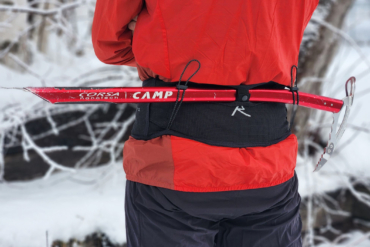Perhaps you’ve seen them walking through the park, striding earnestly, poles pumping at their sides, skiers without any snow. Perhaps you’ve snickered or offered a smart whispered aside. I have, too.
The nascent sport of Nordic walking has a bit of an image hurdle to overcome in the United States. There’s no denying that the sport’s odd cadence and stiff, rhythmic strides look a bit silly. But there’s also no denying its profound leap in popularity over the past couple years. In Finland, for example, an estimated 500,000 people now participate in Nordic walking, according to pole-manufacturer Leki USA.

While acceptance on this side of the Atlantic is not yet so profound, the sport is gaining enough critical mass that dozens of gear companies now cater to the growing market. I recently met up with representatives from Leki and Vasque at a gear demo in Pismo Beach, Calif., for a primer on the sport and an introduction to the companies’ respective Nordic walking poles and shoes.
After pulling on Vasque’s Amp shoes and strapping into Leki’s Instructor poles, I followed former semi-pro ski racer Jon Fewster onto the beach for my first go at the sport. Fewster, who has a Master’s degree in biomechanics and works as a product manager at Vasque, used to train during the off season — like many skiers — running with ski poles. Nordic walking, Fewster explains, is a more refined version of that dry-land ski training.
Essentially, Nordic walkers use their poles to propel themselves. With each step, the leading foot strikes the ground as the opposite arm swings forward to plant the pole. The harder you push off the poles, the less stress on the legs.
Poles are positioned diagonal and down and then thrust back behind as you walk. Elbows are kept close to the body and arms are held fairly straight during pole plants. The foot rolls through the step to push off with the toe and poles are pushed as far back as possible, lengthening your stride.
Being a life-long cross-country skier, I took to Nordic walking with little effort. After just a couple minutes swinging the poles, I understood the movements and could feel the huge physical advantages over a regular walking stride. I was an ignorant cynic at the start of the day and a convert after just 20 minutes on the beach.
Nordic walking works out the whole body and is easy on the joints. You can push as hard or as easy as you want off the poles to add stress to the abdominals and upper body or keep the legs working to the max. Proponents say it burns up to 40 percent more calories than a pole-less walk.
Leki has a line of 11 Nordic walking pole models, with pricing starting at about $70 and going up to $200 with the top-end carbon Pacer Vario model. The Instructor model I used on the beach, which is made of aluminum and carbon, goes for about $150. The poles are distinguished from the company’s trekking models by their swing-weight, variable tip feature and the secure Velcro hand-wrap strap. Other companies that make poles for Nordic walking include Exel and Swix.
While Vasque does not design shoes solely and specifically for the sport, its Amp ($90) and Velocity ($85) models are marketed to Nordic walkers. These models have extra-cushioned heels, stiff arches and that good toe-off motion needed for those exaggerated Nordic strides you’ll make trekking on through the park.






